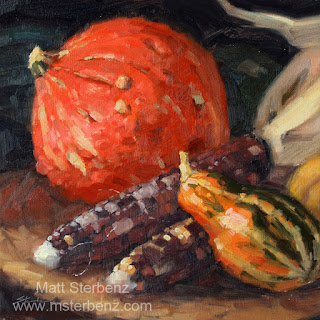Here are some step-by-step photos of this Fall still life from last week. I'll include a little commentary here and there.
My palette: Cadmium yellow light, yellow ochre, cadmium orange, cadmium red light, alizarin crimson, ultramarine blue, viridian hue (Holbein), transparent oxide red (Rembrandt)
I started off by drawing in my composition with a reddish brown and a small #2 brush. Then I started blocking in the shadows. Paint at this stage is kept thin.
Once shadow shapes were established I started blocking in local colors. When I paint local colors, I tend to err on the slightly darker side. I'd rather have to lighten them up later than have to darken them instead. Too much white early on can make your painting look chalky.
I started getting some slightly thicker paint, defining the forms a bit more in the pumpkin and gourde. I was mainly focusing on the light areas. I'll get the shadowed sides a little later.
More definition. This time a little bit in the shadow side of the pumpkin.
Building up some of the reflected lights in the pumpkin. The orange tends to go cool in the highlights. They become kind of a pink color rather than getting very yellow. Cadmium red light and white work well for that.
Building up a little bit of definition on the gourde.
Corn progress 1: Start with a darker than usual local color, painted thinly. Make some guide marks for the rows of kernels.
Using a flat #4-#6, I placed some of the first marks, in varying shades of purple with a couple lighter tan colored marks. I was trying to keep the brush strokes following the curve of the corn cob,
More shapes of color. Some wider, some narrower. Trying to keep colors scattered and random looking.
Getting there...
Now the kernels can be defined a little bit. Some reflected light, shadow shapes, and a couple soft highlights finish it off.

















































